Attached files
| file | filename |
|---|---|
| 8-K - CURRENT REPORT - FIFTH THIRD BANCORP | d8k.htm |
 ©
Fifth Third Bank | All Rights Reserved
UBS Global Financial Services Conference
Kevin T. Kabat
Chairman, President & Chief Executive Officer
May 11, 2010
Please refer to earnings release dated April 22, 2010 and 10-K dated
May 7, 2010 for further information, including full results reported on a U.S.
GAAP basis
Exhibit 99.1 |
 2
©
Fifth Third Bank | All Rights Reserved
1Q10 in review
Significant improvement in credit trends
•
Nonperforming assets declined 3% and nonperforming
loans declined 7% sequentially (lowest levels since
2Q09)
–
Total delinquencies declined 15% sequentially
(lowest level since 3Q07)
•
Net charge-offs declined 18% sequentially (lowest level
since 1Q09)
•
Allowance to loan ratio of 4.91%, 139% of
nonperforming loans and leases and 1.6 times
annualized 1Q10 net charge-offs
•
Realized credit losses have been significantly below
SCAP scenarios
Capital position remains very strong
•
Tangible common equity ratio of 6.4%
•
Tier 1 common ratio of 7.0%
•
Leverage ratio of 12.0% (8.9% ex-TARP)
•
Tier 1 capital ratio of 13.4% (10.0% ex-TARP)
Continued strong operating results
•
Net loss of $10 million versus 4Q09 net loss of $98
million
•
Pre-provision net revenue of $568 million, up $6 million
from 4Q09
•
Net interest margin of 3.63%, up 8 bps sequentially
•
Average core deposits up 6% sequentially
•
Extended $18 billion of new and renewed credit |
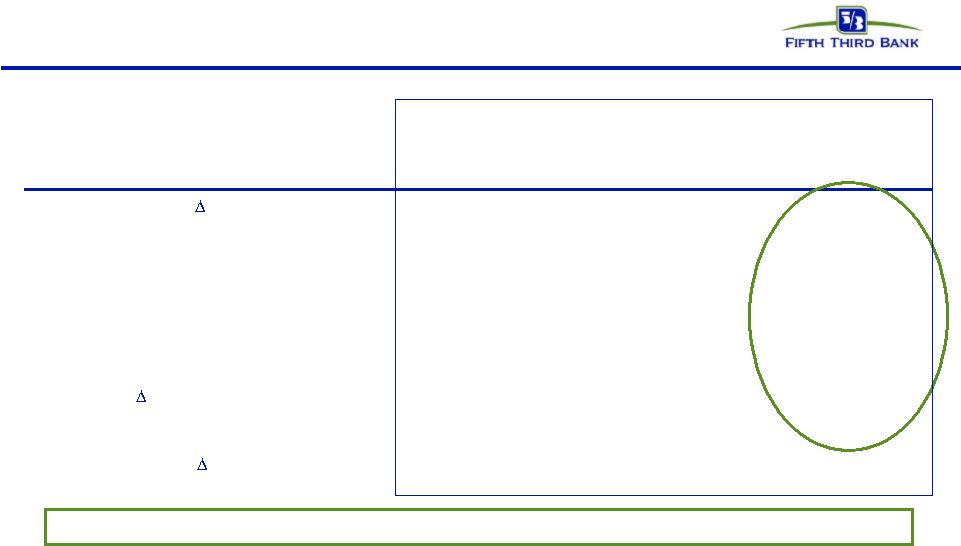 3
©
Fifth Third Bank | All Rights Reserved
Peer performance summary
(1)
Large bank peer average consists of BBT, CMA, HBAN, KEY, MTB, MI, PNC, RF, STI,
USB, WFC, and ZION, unless otherwise noted. (2)
Midwest peer average consists of CMA, HBAN, KEY, MI, and USB, unless
otherwise noted. ^ Operating fee growth, core pre-tax pre-provision
earnings, and operating efficiency ratio exclude the following items where appropriate: securities gains/losses,
gains/losses from debt extinguishments, leveraged lease gains/losses, gains from
asset sales, goodwill impairment charges, and other non-recurring items where
appropriate.
* Average loans include only loans held-for-investment.
** NPAs
exclude loans held-for-sale and covered assets.
Source: SNL and company reports.
Continue to outperform on key value drivers
FITB
1Q10
Regional
bank peers
(1)
1Q10
Midwest
peers
(2)
1Q10
SEQ performance
vs. peers
Net interest margin /
(bps)
3.63% (+8)
3.60% (+13)
3.37% (+18)
Better
Operating fee growth^
-1%
-9%
-5%
Better
Operating efficiency ratio^
62%
64%
65%
Better
Average core deposits growth
6%
0%
0%
Better
Average loan growth*
1%
-1%
-2%
Better
NPA ratio** /
(bps)
4.03% (-18)
4.33% (+11)
3.47% (-7)
Better
Core pre-tax pre-provision earnings^ / loans
2.9%
2.7%
2.6%
Better
Net charge-off ratio /
(bps)
3.01% (-61)
2.48% (-46)
2.86% (-90)
Worse |
 4
©
Fifth Third Bank | All Rights Reserved
Pre-tax pre-provision earnings
Peer average: 2.7%
1Q10 core PPNR / average loans (annualized)*
Core PPNR trend
Fifth
Third’s
pre-tax,
pre-provision
net
revenue
(PPNR)
to
loans
higher
than
most
regional
bank
peers
Core PPNR reconciliation
Credit adjusted PPNR
/ Average Loans
Source: SNL and company reports. Core PPNR excludes securities gains/losses,
gains/losses from debt extinguishments, leveraged lease gains/losses, gains from asset
sales, goodwill impairment charges, divested fees and expenses related to FTPS, and
other non-recurring items where appropriate. Credit-related adjustments include
mortgage
repurchase
expenses,
provision
for
unfunded
commitments
expense,
derivative
valuation
adjustments,
OREO
expenses
and
other
workout
related
expenses.
1Q09
2Q09
3Q09
4Q09
1Q10
Reported PPNR (GAAP)
$511
$2,393
$844
$562
$568
Adjustments:
Gain on sale of Visa shares
-
-
(244)
-
-
BOLI charge
54
-
-
-
-
Gain from sale of processing interest
-
(1,764)
6
-
-
Divested merchant and EFT revenue
(155)
(169)
-
-
-
Class B Visa swap fair value adjustment
-
-
-
-
9
Securities gains/losses
24
(5)
(8)
(2)
(14)
Visa litigation reserve expense
-
-
(73)
-
-
Other litigation reserve expense
-
-
-
22
4
FTPS Warrants
-
-
-
(20)
2
Seasonal pension expense
-
-
10
-
-
FDIC special assessment
-
55
-
-
-
Divested merchant and EFT expense (estimated)
49
54
-
-
-
Core PPNR
$483
$564
$535
$562
$569
Credit
Related
Items:
OREO write-downs, FV adjs, & G/L on loan sales
3
8
45
30
1
Problem asset work-out expenses
94
57
111
73
91
Credit adjusted PPNR
$580
$629
$691
$665
$661 |
 5
©
Fifth Third Bank | All Rights Reserved
Net interest income
Core NII and NIM*
•
Trends in net interest income and net
interest margin favorably compare with
peers
–
NIM up 8 bps in 1Q10 vs. 4Q09
•
Expect continued margin benefit
through 2010 from CD maturities and
improved loan spreads
Reported NIM and YOY growth versus peers
Peers include: BBT, CMA, HBAN, KEY, MI, MTB, PNC, RF, STI, USB, WFC, ZION
Source: SNL and company reports
*
Core results exclude $6M charge related to leveraged lease litigation in 1Q09. Also
excluded are $41M, $35M, $27M, $24M, and $19M in loan discount accretion
from the First Charter acquisition in 1Q09, 2Q09, 3Q09, 4Q09, and 1Q10 respectively.
Yields and rates* |
 6
Fee income and expenses –
core trends*
Core fee income ($M)
Core expenses ($M)
•
Strong mortgage banking results continued in 1Q10,
resulting in $3.5B of originations and $152M in net revenue
•
Investment advisory revenue up 5% from the previous
quarter due to seasonality and growth in brokerage fees
•
Card and processing revenue decreased 4% sequentially
and 8% from the previous year (excluding divested EPP
revenue)
•
Corporate banking revenue down 8% sequentially driven by
declines in business lending fees, foreign exchange
revenue, and institutional sales
•
Credit related cost affected fee income by $1M in 1Q10
compared with $30M the previous quarter
•
Sequential increase in core expenses driven by elevated
credit costs and seasonal benefits expense partially offset
by disciplined discretionary expense control
•
Core efficiency ratio of 62.4% in 1Q10, an improvement from
62.5% in 4Q09 and 65.1% in 1Q09
•
Credit-related costs affected non-interest expenses by $91M
in 1Q10 compared with $73M the previous quarter
•
Total expense related to mortgage repurchases ~$39M in
1Q10 compared with $18M in 4Q09 and $6M in 1Q09
* Refer to slide 4 for itemized effects of non-core fees and expenses
©
Fifth Third Bank | All Rights Reserved |
 7
©
Fifth Third Bank | All Rights Reserved
Liability mix and pricing discipline drive
strong net interest income/NIM results
•
Strong, deposit rich core funding mix
supports relatively low cost of funds
–
Low reliance on wholesale funding
•
Continued pricing discipline on
commercial loans, consistent with market
trends toward better risk-adjusted spreads
–
C&I spreads over 1-month LIBOR
have increased more than 150 bps in
the past two years
Source:
SNL
and
company
reports.
Transaction
deposits
defined
as
DDA,
NOW
and
Savings/MMDA
accounts.
* MI as of 12/31/09
C&I Spread to 1-month LIBOR
1Q10 Cost of Funds Peer Comparison
Peer average 1.10% |
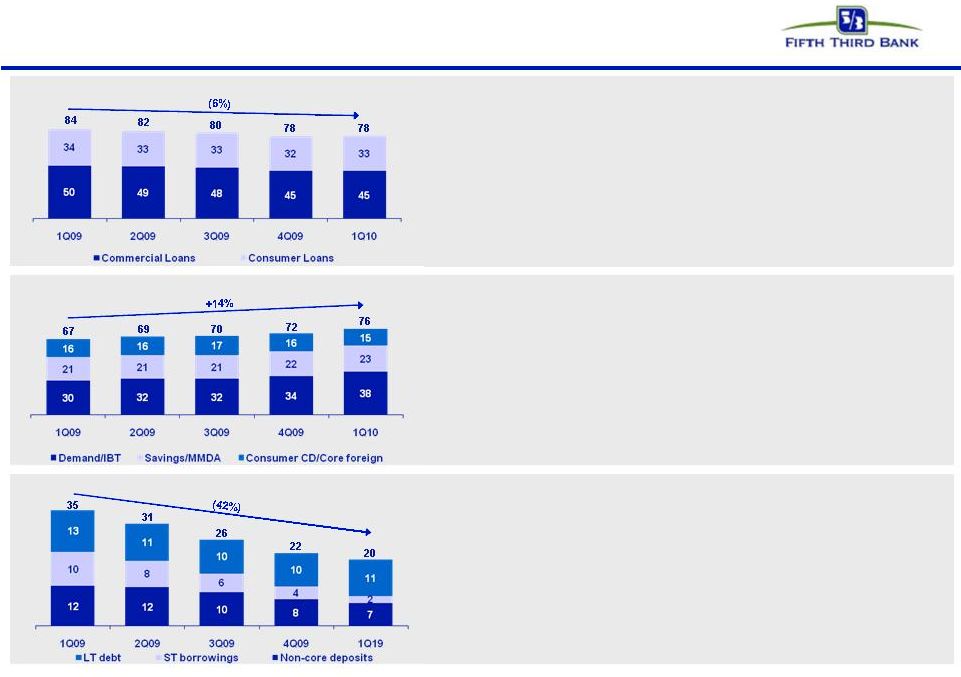 8
©
Fifth Third Bank | All Rights Reserved
Balance sheet:
Continued growth in core funding
•
Extended $18B of new and renewed credit in 1Q10
•
CRE loans down 4% sequentially and 12% from the previous year
–
New homebuilder/developer, non-owner occupied CRE suspended 2008
•
C&I loans down 1% sequentially and 12% from the previous year largely due
to lower line utilization and soft demand*
•
Strong
mortgage
originations
-
$1.5B
in
residential
mortgage
loans
held-for-
sale warehouse (not carried in loans held-for investment)
•
Core deposit to loan ratio of 97%, up from 80% in 1Q09
•
Everyday Great Rates strategy continues to drive core deposit growth
–
DDAs
up 4% sequentially and 21% from the previous year
–
Commercial core deposits up 20% sequentially and 46% from the previous
year
–
Retail
core
deposits
up
1%
sequentially
and
3%
from
the
previous
year
Average loan growth ($B)^
Average core deposit growth ($B)
84
82
80
78
78
67
69
70
72
76
Average wholesale funding ($B)
35
31
26
20
22
•
Reduced
wholesale
funding
by
$1.9
billion
sequentially
and
$14.7
billion
from
the previous year
–
Non-core deposits down 14% sequentially and 40% from the previous year
–
Short term borrowings down 52% sequentially and 84% from the previous
year
–
Long-term debt up 10% sequentially and down 8% from the previous year
•
Portion of excess core funding invested in agency mortgage-backed securities
(balance sheet hedges added to mitigate interest rate risk)
^ Excludes loans held-for-sale
* Excludes the impact of $724M in C&I balances that were consolidated on
January 1, 2010 Note: Numbers may not sum due to rounding
|
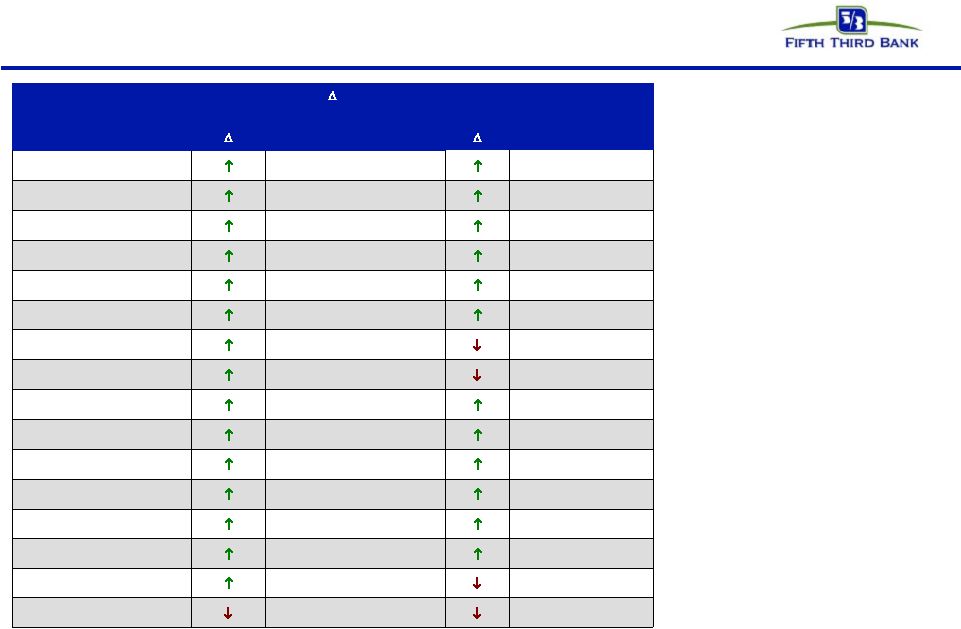 9
©
Fifth Third Bank | All Rights Reserved
Deposit share momentum
Source: FDIC, SNL Financial; branches included are full service retail / brick and
mortar; data excludes headquarters branches with over $250 million in deposits.
•
Continued focus on
customer satisfaction
and building full
relationships has
given strong
momentum to the
retail network
•
Fifth Third grew
deposits in 15 of 16
affiliate markets in
2009
–
Modest attrition in
North Carolina
acquisition market
•
Fifth Third grew
deposit market share
in 75% of affiliate
markets in 2009
Affiliate
5/3 Deposit
(08-09)
5/3 Market Share
Name
Deposit
($)
(%)
Share
2009
2008
Chicago
788,601
9.8%
4.0%
3.8%
Northeastern Ohio
606,708
17.0%
4.2%
3.8%
South Florida
579,342
21.1%
3.1%
2.8%
Eastern Michigan
418,525
11.9%
5.4%
5.0%
Central Florida
338,091
28.9%
3.0%
2.5%
Tampa
334,080
24.5%
3.5%
3.1%
Central Ohio
213,971
5.6%
11.1%
11.2%
Cincinnati
212,656
2.2%
21.5%
21.9%
Southern Indiana
195,169
8.6%
4.1%
4.0%
Louisville
194,593
13.0%
8.9%
8.2%
Northwestern Ohio
177,122
7.5%
16.2%
15.4%
Western Michigan
149,252
2.1%
18.4%
18.4%
Tennessee
142,615
12.8%
3.5%
3.3%
Central Indiana
139,354
4.7%
8.4%
8.3%
Central Kentucky
2,608
0.3%
8.1%
8.7%
North Carolina
(113,631)
-4.4%
4.8%
5.3% |
 10
©
Fifth Third Bank | All Rights Reserved
Continuing to invest for the future |
 11
©
Fifth Third Bank | All Rights Reserved
Strong capital position
Source: SNL and company reports.
* MTB Tier 1 common ratio as of 12/31/09.
Strong capital ratios relative to peers, particularly considering reserve
levels (TCE + reserves) / Loans
Peer average: 12.6%
Peer average w/
TARP: 11.1%
Peer average
w/o TARP: 9.4%
Tier 1 capital ratio (with and without TARP)
Tangible common equity ratio
Peer average: 6.5%
Tier 1 common ratio
Peer average: 7.4% |
  12
©
Fifth Third Bank | All Rights Reserved
Strong reserve position
Industry leading reserve level
Coverage ratios are strong relative to peers
Source: SNL and company reports. NPAs/NPLs
exclude held-for-sale portion for all banks and covered assets for BBT,
USB, and ZION. 1.
FITB
4.91%
2.
KEY
4.34%
3.
ZION
4.05%
4.
HBAN
4.00%
5.
RF
3.61%
6.
MI
3.55%
7.
PNC
3.38%
8.
WFC
3.22%
9.
USB
2.80%
10.
STI
2.79%
11.
BBT
2.65%
12.
CMA
2.42%
13.
MTB
1.75%
Peer Average
3.21%
Reserves / Loans |
 13
©
Fifth Third Bank | All Rights Reserved
Portfolio performance drivers
Performance Largely Driven By
No Participation In
Discontinued or Suspended Lending
* Residential construction-related consumer mortgages intended to be held in
portfolio until permanent financing complete. Jumbo mortgage originations currently
being held due to market conditions.
Geography
•
Florida and Michigan most stressed
•
Remaining Midwest and Southeast performance
reflect economic trends
Products
•
Homebuilder/developer
charge-offs
$81
million
in
1Q10
–
Total charge-off
ratio
3.0%
(2.4%
ex-HBs)
–
Commercial
charge-off
ratio
3.1%
(2.6%
ex-
HBs)
•
Brokered
home
equity
charge-offs
6.2%
in
1Q10
–
Direct home equity portfolio 1.6%
1Q10 NCO Ratios
Coml
Cons
Total
FL/MI
5.5%
5.2%
5.3%
Other
2.3%
2.1%
2.2%
•
Subprime
•
Option ARMs
Discontinued in 2007
•
Brokered home equity ($1.9B)
Suspended in 2008
•
Homebuilder/residential development ($1.3B)
•
Other non-owner occupied commercial RE
excluding homebuilder/developer ($8.0B)
Saleability
•
All mortgages originated for intended sale*
Total
3.1%
2.9%
3.0% |
 14
©
Fifth Third Bank | All Rights Reserved
1Q10 credit results
Year-over-year NCO growth versus peers
NPA ratio versus peers
Year-over-year NPA growth versus peers
Net charge-off ratio versus peers
Source:
SNL
and
company
reports.
NPAs
exclude
loans
held-for-sale
and
covered
assets. |
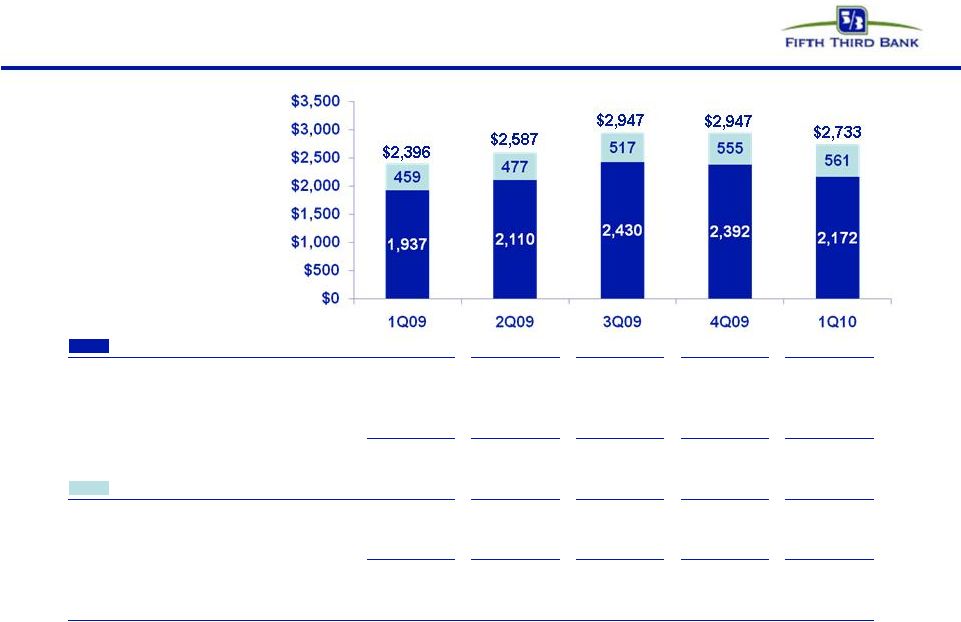 15
©
Fifth Third Bank | All Rights Reserved
Nonperforming loan rollforward
Commercial
($
in
millions)
Beginning NPL amount
$1,406
$1,937
$2,110
$2,430
$2,392
New nonaccrual loans
799
544
832
602
405
Paydowns, transfers, and sales
(157)
(190)
(246)
(332)
(425)
Charge-offs
(111)
(181)
(266)
(308)
(200)
Ending Commercial NPL
$1,937
$2,110
$2,430
$2,392
$2,172
Consumer
Beginning NPL amount
$457
$459
$477
$517
$555
New nonaccrual loans
157
125
160
152
137
Net other activity
(155)
(107)
(120)
(114)
(131)
Ending Consumer NPL
$459
$477
$517
$555
$561
Total
Total NPL
$2,396
$2,587
$2,947
$2,947
$2,733
Total new nonaccrual loans
$956
$669
$992
$754
$542 |
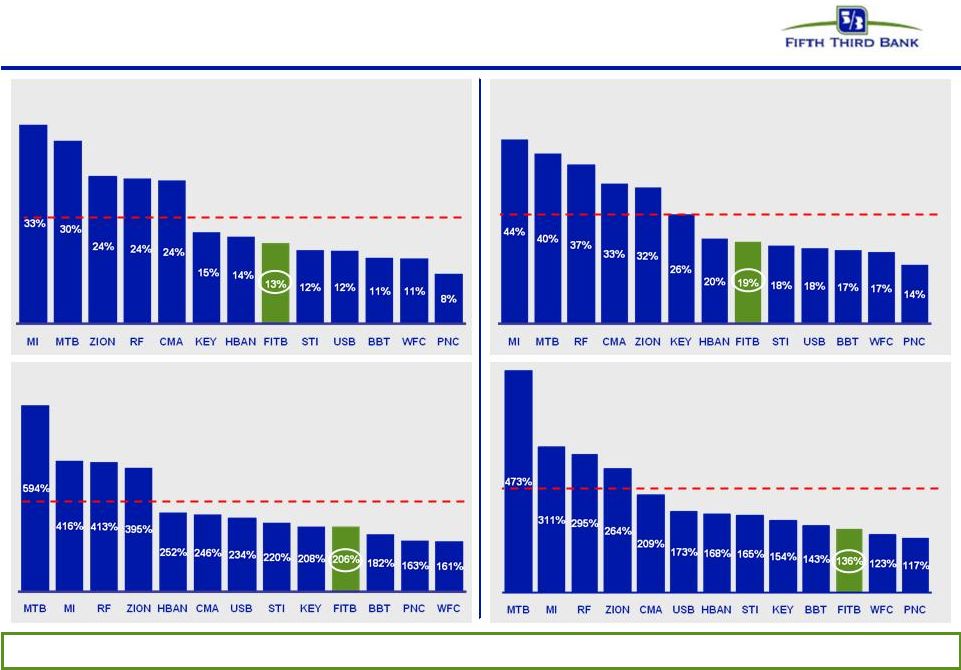 16
©
Fifth Third Bank | All Rights Reserved
Manageable commercial real estate exposure
CRE / TCE
CRE / Assets
Peer average: 290%
Source: SNL and company reports.
CRE / (TCE + Reserves)
CRE / Loans
Peer average: 26%
Peer average: 216%
Peer average: 18%
CRE
exposure
lower
than
peer
average;
problems
relatively
more
manageable
given
capital
and
reserves |
 17
©
Fifth Third Bank | All Rights Reserved
2010 developments
Fifth Third response
Macro themes
•
Sluggish loan demand
•
Deposits to grow but
expect some diminution
as later liquidity drawn
down by deposits to
support expansion in
spending
•
Additional consumer
regulation
•
Higher interest rates late
2010 / early 2011
•
TARP repayment
•
Leverage existing customer relationships at the local level to
offer our full portfolio of products and services across all of our
lines of business
•
Invest in sales force expansion initiatives to increase resources
and branch hours while maintaining focus on a near-term return
to profitability
•
Reorient fee structure of products and services to offer a
clearer and higher value proposition to our clients and create
more sustainable, consistent growth
•
Maintain excess liquidity, neutral to modest asset sensitive
positioning
•
Remain committed to repayment in a manner that is in the best
interest of all constituents, including shareholders |
 18
©
Fifth Third Bank | All Rights Reserved
Summary
Fifth Third continues to execute on its strategic initiatives and
is focused on being well-positioned for the turn of the cycle.
•
Dedicated to serving the needs
of families and businesses for
more than 150 years
•
Businesses creating new and
profitable opportunities to
enhance value
•
Trends in NII and NIM
favorably compare with peers
•
Ongoing expense control
•
Continued shift back toward
core funding
Core franchise remains strong
•
Strong reserve coverage of
problem loans
•
Aggressive management has
mitigated areas of highest risk
•
Significantly enhanced SAG
and workout resources, while
continuing prudent lending
practices
•
Significantly improved credit
trends in 1Q10
Aggressive management of
credit issues
•
Successfully completed June
2008 capital plan and SCAP
capital actions
•
Actions exceeded SCAP Tier 1
common equity commitment
by 80%
•
Current capital levels able to
withstand significant additional
economic deterioration as
demonstrated by the SCAP
assessment
Robust capital levels |
 19
©
Fifth Third Bank | All Rights Reserved
Cautionary statement
This report may contain statements that we believe are “forward-looking statements”
within the meaning of Section 27A of the Securities Act of 1933, as amended, and Rule 175
promulgated thereunder, and Section 21E of the Securities Exchange Act of 1934, as amended, and
Rule 3b-6 promulgated thereunder. These statements relate to our financial condition, results of
operations, plans, objectives, future performance or business. They usually can be identified
by the use of forward-looking language such as “will likely result,” “may,” “are
expected to,” “is anticipated,” “estimate,” “forecast,”
“projected,” “intends to,” or may include other similar words or phrases such as
“believes,” “plans,” “trend,” “objective,”
“continue,” “remain,” or similar expressions, or future or conditional verbs such as “will,” “would,”
“should,” “could,” “might,” “can,” or similar verbs. You
should not place undue reliance on these statements, as they are subject to risks and
uncertainties, including but not limited to the risk factors set forth in our most recent Annual
Report on Form 10-K and our most recent quarterly report on Form 10-Q. When considering
these forward-looking statements, you should keep in mind these risks and uncertainties, as
well as any cautionary statements we may make. Moreover, you should treat these statements as speaking only as of the date they are
made and based only on information then actually known to us.
There are a number of important factors that could cause future results to differ materially from
historical performance and these forward- looking statements. Factors that might cause such
a difference include, but are not limited to: (1) general economic conditions and weakening in
the economy, specifically the real estate market, either nationally or in the states in which Fifth Third, one or more acquired
entities and/or the combined company do business, are less favorable than expected; (2) deteriorating
credit quality; (3) political developments, wars or other hostilities may disrupt or increase
volatility in securities markets or other economic conditions; (4) changes in the interest rate
environment reduce interest margins; (5) prepayment speeds, loan origination and sale volumes, charge-offs and loan loss
provisions; (6) Fifth Third’s ability to maintain required capital levels and adequate sources of
funding and liquidity; (7) maintaining capital requirements may limit Fifth Third’s
operations and potential growth; (8) changes and trends in capital markets; (9) problems encountered
by larger or similar financial institutions may adversely affect the banking industry and/or Fifth
Third (10) competitive pressures among depository institutions increase significantly; (11)
effects of critical accounting policies and judgments; (12) changes in accounting policies or
procedures as may be required by the Financial Accounting Standards Board (FASB) or other regulatory
agencies; (13) legislative or regulatory changes or actions, or significant litigation,
adversely affect Fifth Third, one or more acquired entities and/or the combined company or the
businesses in which Fifth Third, one or more acquired entities and/or the combined company are engaged; (14) ability to
maintain favorable ratings from rating agencies; (15) fluctuation of Fifth Third’s stock price;
(16) ability to attract and retain key personnel; (17) ability to receive dividends from its
subsidiaries; (18) potentially dilutive effect of future acquisitions on current shareholders’ ownership
of Fifth Third; (19) effects of accounting or financial results of one or more acquired entities; (20)
difficulties in separating Fifth Third Processing Solutions from Fifth Third; (21) loss of
income from any sale or potential sale of businesses that could have an adverse effect on Fifth
Third’s earnings and future growth;(22) ability to secure confidential information through the use of computer systems and
telecommunications networks; and (23) the impact of reputational risk created by these developments on
such matters as business generation and retention, funding and liquidity.
You should refer to our periodic and current reports filed with the Securities and Exchange
Commission, or “SEC,” for further information on other factors, which could cause
actual results to be significantly different from those expressed or implied by these forward-looking
statements. |
 20
©
Fifth Third Bank | All Rights Reserved
Updated stress testing -
process overview
Similar
process
to
that
used
in
2008
and
SCAP
processes;
updated
for
actual
performance and current economic expectations
Moody’s
“Base”
and
“Longer
Recession
and
Weaker
Recovery”
case
scenarios
key
economic assumptions
Commercial
—
33 geographic/industry sectors analyzed and regressed against economic and
performance drivers
—
Migration trends from criticized to nonaccrual and charge-off evaluated by
region and industry
Consumer
—
Portfolios subdivided into appropriate categories (i.e. liquidating vs.
non- liquidating home equity)
—
Results derived using combination of regression models, loss curves and roll
rates, and applied economic factors
–
Mortgage and home equity key correlation: HPI
–
Credit card key correlation: unemployment
–
Other consumer key correlations: unemployment and GDP
Base
Adverse
Economic Assumptions*
2010
2010
Peak Unemployment
10.3%
11.4%
GDP
2.4%
0.3%
Avg. change in quarterly HPI
(1.8%)
(2.7%)
* Moody’s Economy.com; as of March 2010 |
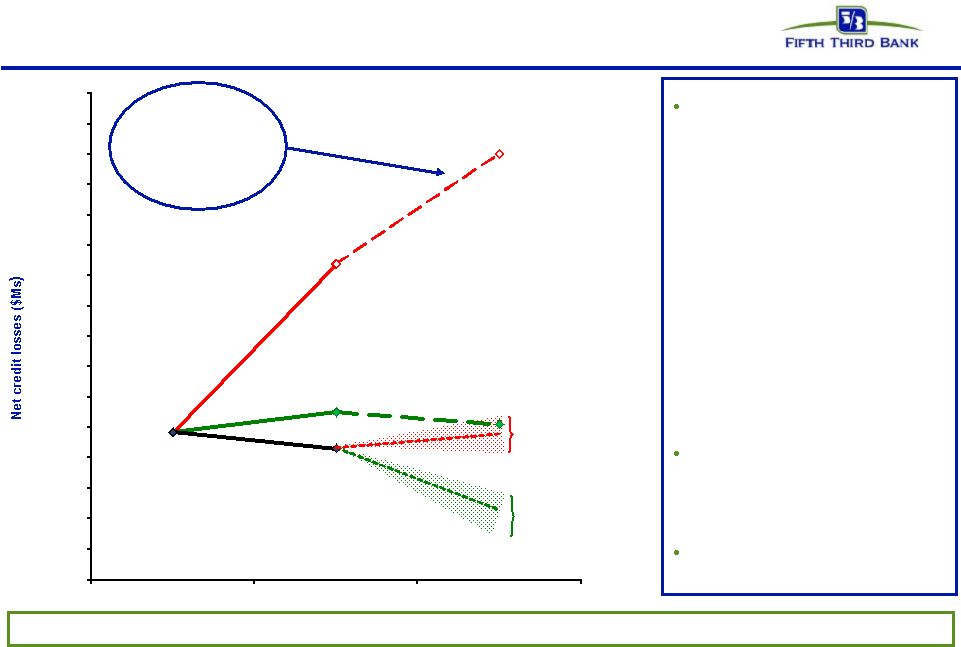 21
©
Fifth Third Bank | All Rights Reserved
Updated credit loss expectations vs. SCAP scenarios
$4.1B
$5.0B
$2.8B
Moody’s Weaker
Recovery / Mild
Second Recession
Case** Assumptions
(Mar. 2010)
Moody’s Base
Case** Assumptions
(Mar. 2010)
Realized credit losses have been significantly below SCAP submissions; expected to
continue SCAP Baseline Scenario
(Submitted; Mar 2009)
SCAP Adverse Scenario
(Supervisory; Mar 2009)
* Red SCAP line represents more adverse scenario as adjusted by supervisors for
additional assumed two-year losses. Supervisory estimates of total two-year losses
under more adverse scenario were not allocated by period. Estimate allocates total
two-year supervisory losses using the allocation under Fifth Third’s submission.
** Source for macroeconomic assumptions: Moody’s Economy.com. Assumptions as
of March 2010. Actual
$2.6B
Actual
$2.7B
Fifth Third
capitalized for this
level of credit losses
under SCAP (plus
surplus raised vs.
buffer)
Fifth Third’s realized credit losses
have been significantly below its
SCAP submitted baseline and
more adverse scenarios
–
In SCAP submissions, we
incorporated significant
conservatism, given then-
prevailing negative economic
and industry trends and
extreme uncertainty in
potential loss outcomes at
the time
–
Economic and credit market
conditions have been much
better than potential
downside expectations in
Spring 2009, benefiting
results vs. SCAP scenarios
Base and stress scenarios reflect
Moody’s Base Case and Moody’s
Weaker Recover / Mild Second
Recession Case (as of March
2010)**
Our current expectation is for
2010 losses to be lower than 2009
$2.9B
$1,500
$1,750
$2,000
$2,250
$2,500
$2,750
$3,000
$3,250
$3,500
$3,750
$4,000
$4,250
$4,500
$4,750
$5,000
$5,250
$5,500
2008
2009
2010 |
 22
©
Fifth Third Bank | All Rights Reserved
Troubled debt restructurings (TDR) overview
Successive improvement in vintage performance during 2008 and
2009, even as volume of modification increased
Fifth Third’s mortgage portfolio TDRs
have redefaulted
at a lower
rate than other bank held portfolio modifications
—
Fifth Third’s TDRs
are about a third less likely to redefault
than modifications on GSE mortgages
Of $1.8B in consumer TDRs, over $1.3B (76%) are current
—
$940M of those have been current more than 6 months,
approximately half of which have been current more than a
year
As current TDRs
season, their default propensity declines
significantly
—
We do not typically see significant defaults on current loans
once a vintage approaches 12 months since modification
Delinquent TDRs
total $415M (24%)
Of $1.8B in consumer TDRs, $1.5B are on accrual status and $271M
are nonaccruals
TDR performance has improved in newer vintages
Outperforming redefault
benchmarks
Source: Fifth Third and OCC/OTS data; data through 3Q09; industry data
cumulative through 3Q09 Mortgage TDR
60+
redefault
trend
by
vintage
1Q08 $69M
2Q08 $135M
3Q08 $146M
4Q08 $176M
1Q09 $221M
2Q09 $257M
Mortgage
TDR
60+
redefault
rate:
Fifth
Third
comparison
(through Sept. 2009)
Fannie Mae
Industry
portfolio loans
Fifth Third
Volume by
vintage
Freddie Mac
3Q09 $386M
Current consumer TDRs
($ MMs) |
 23
©
Fifth Third Bank | All Rights Reserved
Strong liquidity profile
Retail Brokered CD maturities: $813M in 2010; $31M in 2011
–
Institutional Brokered CD maturities: $50M in 2010
3/31 unused avail. capacity $27B ($18.5B in Fed and $8.7B in FHLB)
FHLB borrowings $2.6B; Q1 avg. core deposits $76B; equity $14B
All market borrowings by Fifth Third Bank
Holding Company cash at 3/31/10: $1.35B
Expected cash obligations over the next 12 months (assuming no
TARP repayment)
—
$0 debt maturities
—
~$39M common dividends
—
~$205M preferred dividends
–
~$35M Series G dividend
–
~$170M TARP dividend
—
~$237M interest and other expenses
Cash currently sufficient to satisfy all fixed obligations over the next
24 months (debt maturities, common and preferred dividends,
interest and other expenses) without accessing capital markets or
relying on dividends from subsidiaries
Bank
unsecured
debt
maturities
($M
–
excl.
Brokered
CDs)
Heavily core funded
Holding company unsecured debt maturities ($M) |
